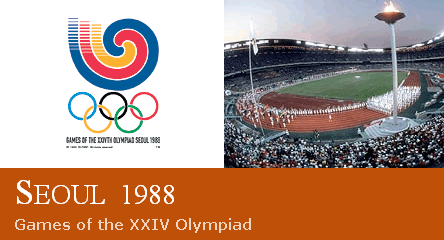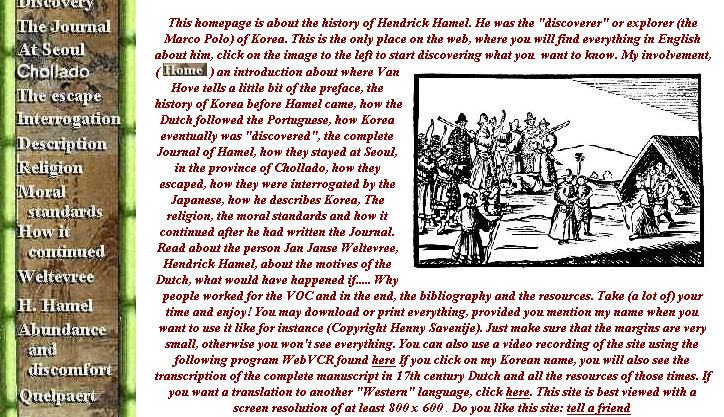 Netherlander Comes in Seoul
Netherlander Comes in Seoul
 Surprisingly, under the bright sunny sky, they appeared with reddish orange umbrellas. Each unfolded umbrella said, "Netherlander comes in Seoul." The Dutch athletes, who were entering the Seoul Olympic Main Stadium during the opening ceremony on September 17, 1988, have not been the only Netherlanders with a conspicuous appearance.
Surprisingly, under the bright sunny sky, they appeared with reddish orange umbrellas. Each unfolded umbrella said, "Netherlander comes in Seoul." The Dutch athletes, who were entering the Seoul Olympic Main Stadium during the opening ceremony on September 17, 1988, have not been the only Netherlanders with a conspicuous appearance.
More than 360 years ago, several Dutch seamen landed in this country. Their big constitution with blue eyes, red moustache and white skin like "barbarians from the South" was a special attraction in town.
Adrift to Korean Peninsula
They had scarcely survived a typhoon, on their way between Taiwan and Nagasaki, Japan. Sadly, they were not allowed to return home because of the isolation policy of the then Yi Dynasty. But their skills and crafts in handling fire-arms made them essential elements in the Korean army. One of them, Jan Janse Weltevree, lived long enough to be Koreanized. He got a Korean name, Park Yeon. He married a Korean woman and had a son and a daughter.
Some thirty years later, Weltevree saw some more countrymen drift ashore in the Land of Morning Calm, this time in a large company of 36 sailors. They were enrolled in the Korean army under the supervision of Weltevree. Before long, they had to be detained in the southern part of the nation. At that time, the Korean government was fearful of any diplomatic dispute with China, which might be triggered by strange foreigners' presence in the capital city.
In 1666, after 13 years of detention, Hendrik Hamel and his fellows escaped the country. His account of the shipwreck off the coast of Korea was published in Holland. Hamel's book stirred the curiosity of Westerners, something like Marco Polo's "Il milione"(the Travels in the Orient).
Western Studies in Japan
It is interesting to see that Dutch sailors, who flowed into the forbidden land of Japan in the early 17th century, were reasonably well received by the Edo Bakufu. Their East Indies Company was granted the Bakufu's permission to trade with Japan on a limited basis. They established a trading post at Tejima, off Nagasaki.
Therefore, next year will mark the 380th anniversary of friendship ties between the Netherlands and Japan. In fact, Tejima was the only window until the Meiji Restoration of 1868, through which the Japanese imported Western civilization, Studies of European modern science, termed 'Rangaku'(Dutch learning), developed rapidly ranging from medicine to military technology in the 18th century.
The Dutch provided Japan with a solid base for modernization into the 20th century. So it is quite natural that the Japanese will make a nationwide celebration of the Dutch harbingers' coming 380 years ago.
In the 17th century, during the Dutch Golden Age, no nation was more aggressive in seafaring than the Dutch people. Amsterdam's shipowners formed the world famous East Indies Company (in the Dutch, initialed 'VOC') which enjoyed a monopoly of trade with Eastern countries. The VOC's major foreign base was Batavia (now Jakarta) on Java. It also set up a stronghold on Formosa. Engaged in the Far Eastern trade linking those ports of Batavia, Formosa and Nagasaki, the VOC's merchant ships more often than not met with typhoons. Several unfortunate Netherlanders became prisoners in Korea, as mentioned above.

* Website on Hendrick Hamel in Korea at http://www.hendrick-hamel.henny-savenije.pe.kr/
Contrary to their uninvited guests from the Western hemisphere, the global view of Koreans covered only neighboring countries - China and Japan. They expected nearly nothing from the barbarians from the South. The full-fledged Western civilization was to be imported through filtration by China.
The situation was different in the Shogun's nation. The Japanese got more or less accustomed to the Europeans. Jesuit missionaries brought exotic merchandise together with Christianity. Sophisticated military equipment including rifles was in great demand by the warring domain lords. After Tokugawa succeeded in unifying the archipelago, he expelled the Jesuit missionaries. But they were soon replaced by the prudent Dutch merchants, who traded anything but Christianity. For instance, an anatomical book imported from the Netherlands was a real surprise to the Japanese scholars.
As the Western studies were progressively vigorous, the scholars became critical of the feudal seclusion system, giving rise to the persecution of ardent admirers of Western civilization. Philipp van Siebold, a German doctor stationed at the Dutch trading post on Tejima, was entangled in the 1828 'Siebold' incident plotted by the Bakufu conservatives.
The Consequence of Modernization Gap
Without doubt, the Dutch people helped their Japanese fellows pave the way toward the modernization that was badly needed after the Meiji Restoration. Naturally, the new government was quick to dispatch a number of missions to Europe to introduce advanced knowledge.
Korea experienced seemingly similar process of importing Western studies through the Catholic missionaries working in Beijing. The "Silhak" scholars of practical learning school advocated comprehensive reform by imitating the Western learning. However, they could never become a mainstream in the government of the country. Some Silhak scholars associated with Catholicism were occasionally persecuted by the feudal authorities.
At last, the scholars of Western studies were by and large mistaken for Catholic believers. In as much as the Korean government detested Catholicism, they could not find any chance to employ their knowledge in policy-making.
In the race to modernization, Korea and Japan started almost at the same time. In the course of two centuries, the Japanese accomplished everything with the help of the Dutch, while the Korean exploited few advantages by fervently rejecting Western influences. By the turn of the century, Japan rose to become a Bigh Power in the Far East. On the contrary, Korea was on the brink of becoming a colonial state.
Jesus' saying is appropriate to show the discrepancy. "When a peasant sowed seed in his field, what was sown on rocky ground of among thorns proves unfruitful. But what was sown on good soil indeed bears fruit and yields more than a hundred-fold."(Matthew 3:23)
In the year of 1988, however, Korea has finally overcome the bondage of the past. The Seoul Olympiad demonstrated the full responsibility and capacity of the nation in the international community. It is because Korean culture and lifestyles were beautifully presented before a world audience. The same day, those Dutch athletes made a dashing impression, too. The most frequently voice catchphrase was "From Seoul to the World!" Surely, it will be so in the future.
- Source: Whon Il Park, Thoughts of the Times, The Korea Times, November 1, 1988.
The writer studied the European Integration at the University of Amsterdam (ICEI) under the fellowship of the Dutch government during 1986-87.
 Surprisingly, under the bright sunny sky, they appeared with reddish orange umbrellas. Each unfolded umbrella said, "Netherlander comes in Seoul." The Dutch athletes, who were entering the Seoul Olympic Main Stadium during the opening ceremony on September 17, 1988, have not been the only Netherlanders with a conspicuous appearance.
Surprisingly, under the bright sunny sky, they appeared with reddish orange umbrellas. Each unfolded umbrella said, "Netherlander comes in Seoul." The Dutch athletes, who were entering the Seoul Olympic Main Stadium during the opening ceremony on September 17, 1988, have not been the only Netherlanders with a conspicuous appearance.
